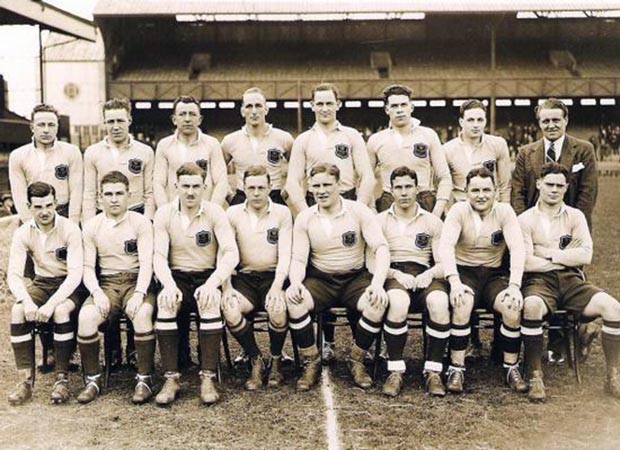 Through adversity to the stars, as the RAF motto proclaims. Taking on the might of the Army and Navy has always been a tall order for any RAF XV but as you would expect Britain’s aviators have often managed to flourish by dint of their wit, intelligence and coolness under pressure.
Through adversity to the stars, as the RAF motto proclaims. Taking on the might of the Army and Navy has always been a tall order for any RAF XV but as you would expect Britain’s aviators have often managed to flourish by dint of their wit, intelligence and coolness under pressure.
Wavell-Wakefield set the tone straight after World War I when, as the youthful secretary of the RAF team, he badgered the Navy to finally grant them an annual fixture although initially the senior service would not award ‘caps’ against the upstart airmen. At which stage the formidable figure of Chief of Air Staff Lord Trenchard intervened, cornering the RAF-loving King George at Twickenham one day to point out this ‘oversight’.
The King promptly called for the First Sea Lord and the conversation was short and sweet: “I would like to know more about this insult to my Royal Air Force.”
So the RAF were brought into the fold ‘pdq’ but that didn’t make actually beating the Navy any easier which is where Wakefield again took over. A precocious rugby and indeed all-round sporting talent, Wakefield was already a regular in the Harlequins and England teams and felt the RAF could ultimately field a much stronger XV if the six or seven quality players they possessed played regular top level club rugby during the season to hone their talents.
The RAF top brass, almost to a man, disagreed violently with Wakefield but the junior officer then boldly took his plans to Lord Trenchard who immediately understood his reasoning – and the need for the RAF to justify their new status on the rugby field. Wakefield was given the green light and along with the cream of the RAF rugby crop were spared weekly matches for their stations and squadrons and were only drafted into the RAF squad shortly before the Army and Navy game. The result was that RAF rugby achieved take off with a first ever Inter-Services title in 1922.
Douglas Bader was another larger than life character, a blazing rugby talent with the RAF and Quins where Adrian Stoop rather fancied he had unearthed the next Ronnie Poulton-Palmer. Bader, a fly-half/centre, had just played for the Combined Services against the 1931-32 Springboks and was hoping for an England call-up in the New Year when disaster struck.
It was the morning of December 14 1931 when the irrepressible Bader indulged in some extracurricular aerobatics in his Bulldog trainer at Woodley aerodrome near Reading when he came in too low on one approach and his wingtip hit the ground. His plane was a write-off and Bader was rushed to the Royal Berkshire where he had both legs amputated.
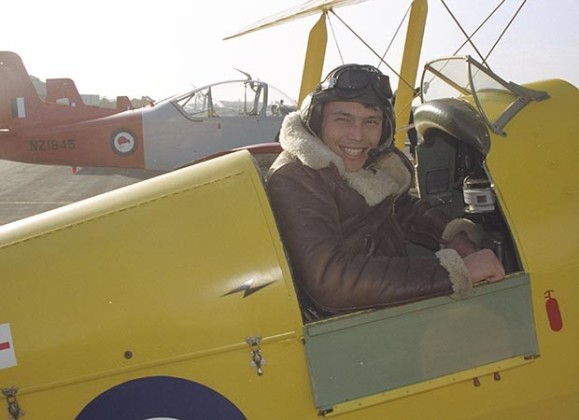
No more rugby for the RAF, Quins or anybody although, remarkably, he returned to flying duties and won the DFC and bar and DSO and bar before ending up as a POW at Colditz where he spent every waking hour trying to escape.
Another notable RAF rugby player with marked escaping tendencies was their stalwart flanker Ken Rees who also captained London Welsh and starred for Cheshire in their County Championship win of 1950. In fact, many insist Rees was the original ‘cooler king’ the individual who somehow morphed into the mythical Steve McQueen character in The Great Escape film The diminutive Rees was piloting a Wellington bomber when shot down and crash landing in a lake in Norway and made himself a thorough nuisance at various POW camps before being sent to Stalag Luft 111 in Silesia. Being short and Welsh it was assumed that he would have some sort of mining skills, although in fact he was a draper by training, and was put in charge of one of the tunnels planned for the mass breakout – the 330 foot long Harry – which in the event was the only one used.
Rees worked at the face of the tunnel most of the time, helping to shift 250 tons of soil before the breakout on the night of March 24-25 1944. Over 200 POWs were ready to flee but only 76 had exited the tunnel when the Germans realised what was occurring. Rees had to scuttle back along the tunnel to Hut 104 where after being threatened with summary execution he found himself in the cooler. Again.
Rees always played down his omission from the film and made light of any comparisons with himself and McQueen: “He is taller than I am, I’m heavier than he is, he’s American and I’m a Welshman, he rode a motorbike I don’t – the only things we’ve got in common is that we both seemed to annoy the Germans and ended up doing stretches in the cooler.”
Still with the RAF he later commanded a Valiant V-bomber squadron tasked with delivering an atomic bomb on Moscow should the need arise. And after all that excitement he retired to become a postmaster in North Wales.
Bleddyn Williams, the ‘Prince of Centres’, was another RAF pilot in World War II, training as a fighter pilot in Arizona, before returning to Britain where he played plenty of representative rugby for the RAF and Combined Services. He later switched to gliders where he saw service in the Operation Varsity, the so-called Battle of the Rhine, in March 1945.
Williams in particular recalled two RAF wins over a South Wales XV groaning with internationals at Swansea and the pleasure of playing alongside great Welsh talents such as Willie Davies, Alan Edwards and Ike Owens, who had switched to Rugby League but who, as a member of HM Forces, were entitled to represent the RAF at Union.
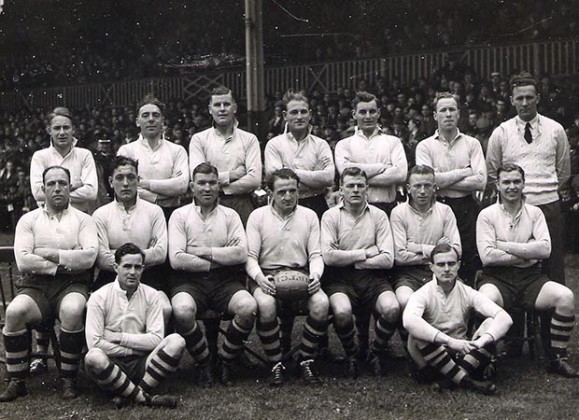
“That was some side the RAF could muster around that time,” Williams once recalled to me. “We had England front- row players like Ray Longland and Bert Toft. They didn’t give much away. Ray was the fitness man at a base at Skegness. Bob Weighill was a fine player who won England caps, Keith Geddes was a future Scotland wing, of course, and we had the great Wales flanker Arthur Rees. Arthur and Keith were both fighter pilots. Gus Walker, who became Air Chief Marshall, was another England player and supporter of the team but had lost an arm in an accident at RAF Syerston.
“And then we had some of the Rugby League guys who were very tough men, extremely fit and talented. I’m pretty sure Ike was one of the RAF’s top parachute jump trainers. Fighting the war was obviously the priority but some of the rugby we squeezed in was very good indeed.”
Williams wasn’t exaggerating about squeezing games in. At the height of Operation Varsity, having crash-landed with his valuable cargo of medical and radio supplies, he had been living rough – along with everybody else – in the ditches and fields next to the Rhine. One morning he was approached by his commanding officer, Hugh Bartlett DFC, the dashing Sussex batsman in Civvie Street.
“Williams aren’t you meant to be at Welford Road tomorrow playing for the British Services against the Dominions?” enquired Bartlett.
“Well, yes, I was picked, sir, but then this show came up,” replied Williams.
“They need you. Go now!”
So Williams retreated promptly to an airstrip behind the Allied lines, caught the last supply plane to Brize Norton that night and was running out in front of a packed house at Welford Road the following afternoon. He even scored a glorious try although he couldn’t prevent a Dominions victory.
After World War II National Service also threw up all sorts of assorted talent – Wales and Lions lock RH Williams, Don Rutherford, Jim Greenwood, Onllwyn Brace and Lew Cannell while among regular officers who made their mark while serving with the RAF have been George Beamish, and his three rugby playing brothers, Bob Stirling, Jeff Young, Lions wing Billy Steel, England locks Peter Larter and John Orwin and full-back Paul Hull.
And, of course, Rory Underwood who served as a pilot throughout his record breaking England career which encompassed 85 Tests and 49 tries. England’s previous top try-scorer was another RAF man, Cyril Lowe.
Much give and take on both sides – and a huge personal effort on Underwood’s part – saw him combine flying duties with 360 and 100 squadrons at RAF Wyton with, in effect, a full-time commitment to Leicester and England. Only towards the end of his rugby career did he take a ground-based instruction job at RAF Cranwell.

Underwood, who never missed an Inter Services game, also took a starring role in probably the most spectacular rugby Press conference in history. Back in 1995, as reigning Inter Services champions, the RAF invited us to make ourselves known at RAF Brize Norton at some ridiculous dawn hour one glorious March morning.
Once there, we were bidden onto a gunboat grey VC10 and as we climbed to 33,000 feet to an ‘RV’ 80 miles east of Sunderland their top brass did the Press conference bit while Brize Norton mess stewards served hot bacon butties and coffee. With the conference over we were ordered to move in an orderly fashion to the left of the plane for a demonstration of the RAF teamwork at its best.
At which point a Victor swooped into view with Rory Underwood in close attendance in his Hawk jet talking to us on his intercom which was being relayed into the VC10. We were then invited one by one to move up into the VC10 cockpit to observe, just feet away, the extraordinary business of inflight docking and refuelling as the Victor pumped the VC10 full of fuel.
Panache and style, you would expect nothing less from the RAF and their rugby players.


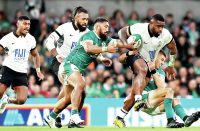
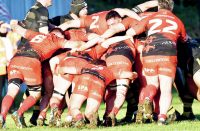
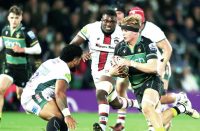



















Pingback: jarisakti